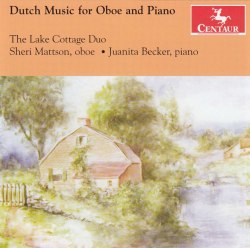|

Support us financially by purchasing
this disc through MusicWeb
for £13.50 postage paid world-wide.

|
Dutch Music for Oboe and Piano
Julius RÖNTGEN (1855-1932)
Hirtenlied (1917) [3:55]
Oboe Sonata No.1 (1918) [15:29]
Oboe Sonata No.2 in D major (1928) [13:50]
Alexander VOORMOLEN (1895-1980)
Pastorale (1940) [5:40]
Hendrik ANDRIESSEN (1892-1981)
Ballade (1952) [6:26]
Henk BADINGS (1907-1998)
Cavatina (1952) [5:02]
The Lake Cottage Duo (Sheri Mattson (oboe) and Juanita Becker (piano))
rec. May 2010 and January 2011, Hart Recital Hall, University of Central Missouri, Warrensburg
CENTAUR CRC 3234 [50:25]
The four featured composers were born within a near-half century period. The oldest is Julius Röntgen who has begun to get his due on disc after many years of near-neglect. Indeed there are now competing versions of some of his major works, such as the Cello Concertos, which gives collectors a nice frisson. He also bears much the greatest weight of the four, since he’s represented by the two sonatas and by his Hirtenlied.
This last was composed in 1917 for oboe and string quartet and is here arranged - I’m not sure by whom - for oboe and piano. As so often Röntgen is adept at instrumental soliloquies and the oboe flurries lyrically through one such. It’s a genial work for 1917, warm-hearted and attractive. The following year he completed his First Oboe Sonata. The opening Allegretto is genial though lacking truly memorable substance and the heartbeat of the work resides in the slow movement. Here the piano’s chordal progression is beautifully calibrated and the oboe responds with vivid personality. Am I mistaken or is the finale sign-off a kind of approximation of ‘au revoir’? It sounds delicious. So, it’s a slightly uneven work that at its best is personable and individualistic.
A decade later Röntgen wrote his second sonata. It’s cut from his best late-romantic stock of droll geniality. The distribution of melody lines is apt and there’s a particularly winning finale which includes a slow reminiscence of earlier material - after which confidence and brio resume.
Voormolen’s 1940 Pastorale is essentially elegant, as its title suggests, but one detects uncertain minor chords from the piano that suggest a subtle duality, which would hardly be surprising, given the date of composition. Both Hendrik Andriessen’s Ballade and Henk Badings’ Cavatina were written in 1952. The Ballade is not quite the easy-going number you might expect from its title - it’s fluid and lyric but also decidedly melancholic. Badings’ Cavatina was originally written for alto flute and harp but is here heard in another arrangement; again, I don’t know whether it’s composer-sanctioned or not. This is cast in clean, clear Francophile style.
The performances are certainly more than dutiful, and the recording is well judged.
Jonathan Woolf
|
